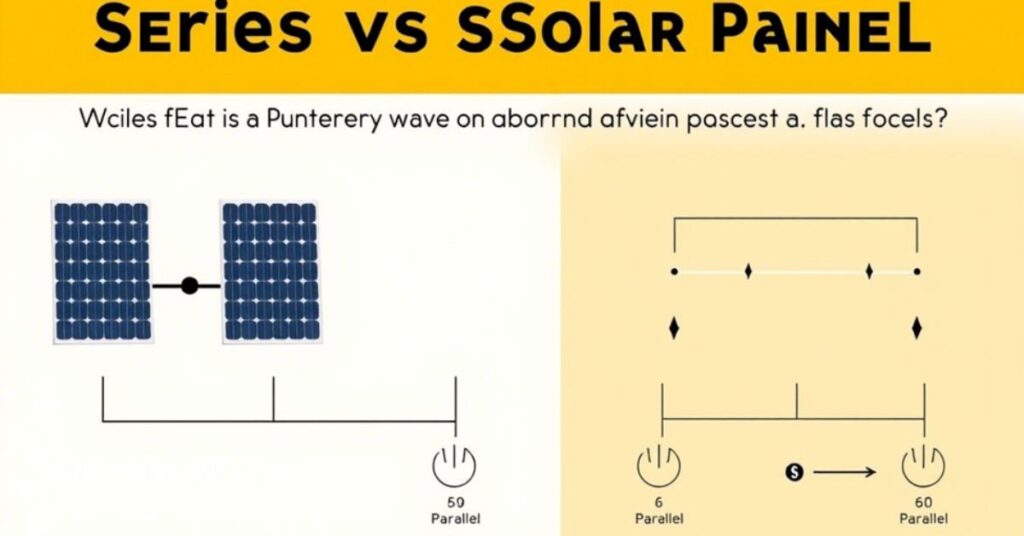I’ve been staring at my solar setup plans for days, wondering if I should go with series or parallel wiring. Everyone seems to have a different opinion, and I just want my system to work efficiently without making a costly mistake. It’s honestly confusing, especially when all I want is a setup that powers my home the best way possible. If you’re in the same boat, you’re not alone.
This blog post breaks down the difference between Series vs parallel solar panels in plain, simple words. You’ll learn how each wiring method works, their pros and cons, and which one suits your specific needs best. By the end, you’ll feel more confident in choosing the right setup for your solar system. Let’s make this decision easy and stress-free.
Understanding Solar Panel Wiring Basics
Wiring is the backbone of any solar panel system. It decides how electricity flows from the panels to your home or battery. Before choosing series vs parallel solar panels, it’s important to understand the basics.
In simple terms, solar panels can be connected in two main ways, series or parallel. Each wiring method affects the system’s voltage and current differently. Knowing this helps you build a more efficient and reliable setup.
What Is Series Wiring in Solar Panels?
In series wiring, solar panels are connected end-to-end, like a chain. The positive terminal of one panel connects to the negative terminal of the next. This increases the total voltage while the current stays the same.
Series wiring works best when all panels get equal sunlight. But if one panel is shaded, it can lower the performance of the whole system.
How Parallel Wiring Works in Solar Systems
In parallel wiring, all the solar panels’ positive terminals connect together, and all the negative terminals connect together too. This keeps the voltage the same but increases the current. It’s like running multiple lanes of traffic at the same speed.
Parallel setups are great if your panels get uneven sunlight. If one panel is shaded, the others still work at full power. That means your system stays more stable and reliable.
Key Differences: Series vs Parallel Solar Panels
The main difference between series vs parallel solar panels is how they handle voltage and current. Series increases voltage but keeps current the same, while parallel increases current and keeps voltage the same. This affects how much power flows and how efficiently it’s used.
Another key difference is shading. In series, one shaded panel can affect the whole system. But in parallel, each panel works independently, making it better for mixed sunlight conditions.
Performance Comparison in Real-World Conditions
In real-world conditions, series vs parallel solar panels perform differently based on sunlight, panel placement, and shading. Series wiring works best in wide-open spaces with full sunlight all day. It delivers strong voltage but can drop performance if one panel is shaded.
Parallel wiring is more reliable in mixed conditions, like rooftops with partial shade or panels facing different angles. It keeps your system stable even if one panel underperforms. Your location and sunlight patterns decide which setup performs better.
Which Wiring Is Better for Your Solar Setup?
Choosing between series vs parallel solar panels depends on your specific needs and environment. If your panels get even sunlight and you want higher voltage, series wiring is a solid choice. It’s simple and works well for smaller, consistent setups.
But if your panels might face shade at different times or are installed on separate roof sections, parallel wiring is better. It keeps your system running smoothly even when one panel isn’t at its best. Always match your wiring to your sunlight conditions and energy goals.
Common Mistakes to Avoid When Choosing a Wiring Method
When comparing series vs parallel solar panels, one big mistake is ignoring shading. Even light shade on one panel in a series setup can drag down your whole system’s performance. Always consider how much sun each panel gets throughout the day.
Another mistake is mismatching panel specs like voltage and current. Mixing different panels can cause imbalance and damage your system. Also, don’t forget to check if your inverter supports the voltage or current from your chosen wiring method.
FAQ’s
What does series wiring do in a solar panel system?
Series wiring increases voltage while keeping the current the same. In the debate of series vs parallel solar panels, this setup suits open, sunny spaces best.
How does parallel wiring affect solar panel performance?
Parallel wiring boosts current but keeps voltage steady. When comparing series vs parallel solar panels, parallel works better in shaded or uneven sunlight areas.
Which wiring is better for homes with shading issues?
For homes with trees or roof shadows, parallel wiring performs better. Series vs parallel solar panels show that parallel handles shading without losing full system power.
Does series wiring reduce efficiency if one panel is shaded?
Yes, one shaded panel in a series setup lowers the entire system’s output. That’s a key drawback when comparing series vs parallel solar panels for home use.
Can I mix different types of solar panels in a system?
Mixing panels is tricky and not ideal for either method. In series vs parallel solar panels, mismatched panels can cause power loss or system imbalance.
Conclusion
Choosing between series vs parallel solar panels can feel overwhelming, but it all comes down to your setup and sunlight conditions. Series wiring gives more voltage and works great in full sun. Parallel wiring keeps your system steady even with shade or panel mismatches.
Now that you understand the basics, pros, and real-world performance, you’re ready to make the right choice. Whether you’re building a rooftop system or a ground setup, knowing how series vs parallel solar panels work helps you get the most out of your investment.
READ: Why Premium Asphalt Shingles Are a Worthwhile Investment for Your Wilmington Home

